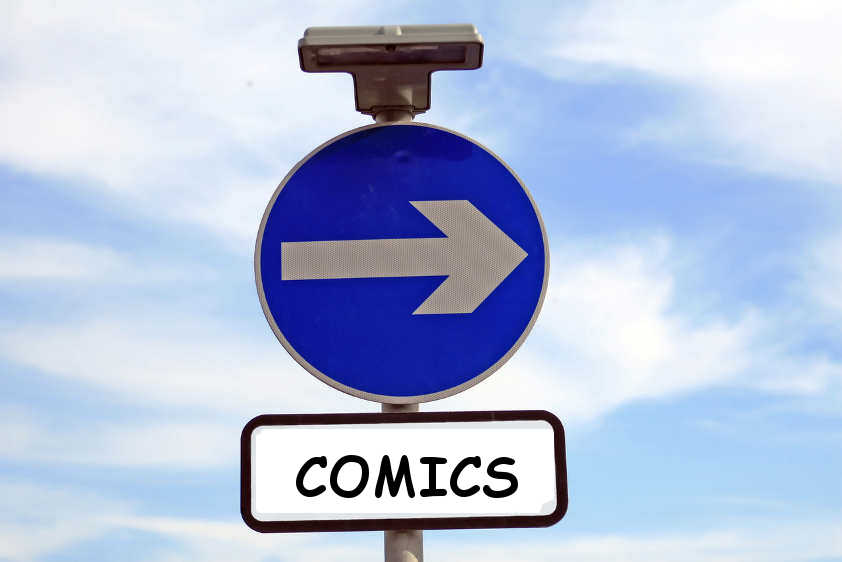Comic Making Process
You have no idea how much work goes on in making a single comic book. To be more accurate, I didn’t have any idea just how much work goes into the making of a single comic. The comic making process is a long and arduous one. Each step could easily be done by a dozen of individuals. Other times the whole process is managed and completed by one person. The workload is monumental. The man hours nearly incalculable depending on the project size. The roles played can be a specialization on their own. From conception to final draft, this process is one heck of a ride.
This process may differ from that of webcomics, but it still has its similarities. Another article will cover the process for webcomics.
The Breakdown
Conception
Nothing great is ever accomplished without thought.
To come up with a new fresh comic you are going to need time and some pretty cool daydreams.
Typically, new stories are created by a from a writer or editors idea for a storyline.
Plot Development
This is the planning stage in the comic making process.
The basic idea of the comic is further developed and broadened into a clear (enough) storyline that can be worked off of.
Consideration for clarity and logic is given in this stage of the comic making process. You don’t want a story that doesn’t make sense.
Tools like storyboards and emotion graphs come in handy at this stage, but can be used in further steps.
Like the article so far? Support the production of more articles like this one!
Script
Writers, while using the plot outline as a guide, writes the script for the comic. Depending on the publisher, the format can matter at this stage.
As a writer, this is your one chance to tell the story how you want it to. It needs to be clear because the script sets the pace for the rest of the process.
Verbal plot notes to an artist can be used instead of a written script. An artist can then make a storyboard instead.
Art Production
Multiple artists can be working on a single comic at a time.
These artists can easily be doing different roles in the production of a comic. These roles are:
1. Penciling (first)
- Determines the look of a comic.
- Could be responsible for producing storyboards via verbal plot notes from writer or editor. This step can be skipped.
- Once approved, penciler goes about illustrating full comic in pencil.
- Photoshop is commonly used in digital penciling.
2. Inking (seconds)
- Inkers are responsible for producing the final linear of the comic with ink.
- They decide which lines are necessary for the finished image. They could correct mistakes done by the penciler.
- It is not uncommon for some artists to skip right into the inking stage without penciling.
3. Colouring (third)
- This is not a necessary step, many popular comics don’t have any other color other than black, gray and white.
- Most cases are done on a computer.
- Colorists must work with the lines outlined by the inker and must aim to compliment them with color.
- These steps can easily be done digitally.
The size of the art team can vary, sometimes a creator can easily find himself doing all roles by himself.
In this process, the editor makes the process easier for the collaborators and makes sure that a certain level of quality is maintained throughout the production of a comic.
Lettering
A letterer then inserts dialogue balloons or boxes into the panels of the comic and starts to type the text. Either by hand or with a computer.
The storyboard stage would help with the consideration for proper placement of dialogue balloons. I have read hundreds of nightmare stories of comic book makers failing to give themselves room for dialogue balloons or text.
You never want the dialogue to compete with the art. Comics are a wonderful harmonization of both the written and the unwritten.
Editing
You will always want to take a look at the “supposed” final draft. The editor should always take a last minute look to make sure everything looks ship shape. Removing any content issues before publishing.
There You Have It
After all of that, you have a completed comic. I wanted to talk about the general process of creating a comic according to my research. Later on, this article will include other insights in further steps in the production of a comic. I feel that it would be more appropriate with the opinions and experience of published creators.
I hope you found this article to be eyeopening. It will never be intended to be demoralizing, but invigorating. The comic making process is a challenge, for either an individual or a collaborative. It sure is helping me out sharing what I learn about making comics. I hope to include my experiences in the making of my own comic later down the line.
Sign Up For
The Unknown Times!
Content Updates
Website News
Recommended Reading
And More to Come!
*Once every two weeks!*
Liked the article? Become part of my Patreon Community!
About The Author

Phillip Allen
Writer, Editor, and Founder of Unknown Comics
Hello there! My name is Phillip Allen and I'm the writer, editor, and founder of Unknown Comics. I am an aspiring comic book creator. In an attempt to learn how to create my own comic I came to learn just how few reliable resources existed out there. From a few books and unhelpful websites I decided to focus my attention on researching and writing a resource for both myself and the rest of the comic creating industry. This website and and its content is the result of all of that hard work.

